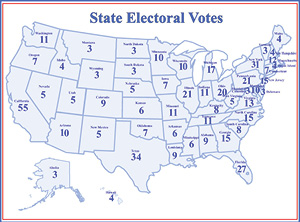
By Matt Haldane
Copper Area News
To many, the United States Electoral College system seems like an antiquated voting mechanism that has no place in the Information Age. With computers and modern communication, it is easy to get accurate election results quickly, which leaves people confused as to why the country does not use a national popular vote to elect the president.
In historical context, it is not such a tragedy that we wound up with the Electoral College. Having the president elected by congress was a serious consideration at the Constitutional Convention of 1787. The Electoral College system (as it would come to be called in the 20th century) was proposed as a compromise between that and a popular vote.
The Constitution allows each state a number of electors equal to its number of representatives in congress (the number of representatives in the House plus its two senators). The members of the House are determined by a state’s congressional districts. Arizona has nine districts, so it has nine House representatives. With its two senators, Arizona has a total of 11 electoral votes. These electors are the people we are actually voting for and the electors vote for the president. Today, 26 states and Washington, D.C. (which was granted 3 electoral votes by the 23rd Amendment in 1961) have passed laws binding their electors to either the party or candidate who won each district. Arizona has not passed such a law but has never had a problem with rogue electors.
This system has advantaged smaller states from the beginning, giving them a disproportionately larger number of representatives relative to their populations. Smaller states were quick to support this system because they believed it would keep larger states from dominating public policy. Today, critics worry that the Electoral College system has given undue influence to swing states like Ohio, where recent candidates have launched relentless campaign efforts. With the 2010 Supreme Court decision on Citizens United v. Federal Election Commission lifting certain restrictions on private funding of political advertising, Ohio residents were feeling particularly election weary by November 2012.
One pitfall of the Electoral College is that it makes it more likely that candidates would not get a majority of the votes, leaving the outcome of the election to the House of Representatives. This is a very remote possibility, though. This has only happened once, when the election of 1800 ended in a tie, and it has never happened under modern election rules.
When the Constitution was still relatively new and had far more kinks to be ironed out, one of the flaws was to allow electors to vote for two candidates for president. This was meant to increase the possibility that one candidate would receive a majority of the electoral votes, but the rise of political parties was not anticipated at the time. Vice presidents were also elected by having the second largest number of electoral votes, so they were not voted for separately. This changed with the 12th Amendment.
The election of 1800 saw Thomas Jefferson and Aaron Burr (you may know him as the only sitting vice president to kill a man when he shot Alexander Hamilton in a duel) tie with 73 electoral votes each. The House decided on Jefferson only after Hamilton wrote letters trying to convince members of congress that Jefferson was the lesser of two evils (the rivalry between Burr and Hamilton had a long history by this point).
So it went that the United States survived its only tie in the electoral college. Today, presidents and vice presidents are elected separately, although in practice the presidential candidate chooses his vice president and the electors follow.
Now that the country has 50 states and 538 electoral votes, the likelihood of a tie is very slim. Champions of allocating electoral votes by district think it would make campaigns more competitive and might even give some hope for third party candidates. Even so, the odds of an election ending without a majority of electoral votes remains improbable.
For various reasons, however, states continue to try to change how electoral votes are doled out. It usually comes down to party politics. Apportioning votes by congressional district always seems most appealing to the party that most recently lost a presidential election.
The National Conference of State Legislatures notes on its website that “since the highly controversial 2000 presidential election, bills have been introduced in every state in the country to change the process for selecting electors.” Most of these bills proposed between 2001 and 2006 focused on the congressional district method. In 2004, Colorado proposed dividing its votes up according to the proportion of the popular vote going to each candidate.
None of the proposed changes passed and today Maine and Nebraska remain the only two states that apportion votes by congressional district and not the popular vote. The 2008 election remains the only one in which a state—Nevada—divided its votes between the two candidates. Obama received one electoral vote from the state.

